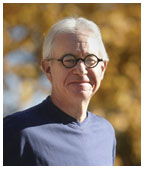
|
December 13, 2006: A moment with...
(Photo by Frank Wojciechowski) |
Greil Marcus
For four decades, Greil Marcus has written about culture, primarily as a music critic, in magazines like Rolling Stone and Interview and in 10 books, including The Shape of Things to Come: Prophecy and the American Voice, published in September. Marcus, a Ferris Professor of Journalism for the fall semester, recently spoke with PAW’s Brett Tomlinson.
This is your third time teaching at Princeton in the last seven years. What is the focus of your current course, “Writing About the Arts”?
Practical criticism is really the concept of the course, and that means criticism written by people for whom it really is a practice. They might be writing about music or movies or architecture or restaurants, but the concept is that when people write about stuff that other people care about but that’s not presumed to be important, they have the freedom to write about absolutely anything without having to worry that people are going to come down on them for [the positions they take].
One of the best examples is a woman named Dara Moskowitz, the restaurant critic for City Pages, the weekly newspaper in the Twin Cities. She writes a restaurant column ... but along with writing about the restaurant, she is also writing a critique of life in the Twin Cities. She’s writing about manners, she’s writing about the way people speak, she’s writing about trends. She’s writing about what people want out of life and what they do to get it — how they’re gratified and how they’re cheated. The whole city becomes her subject, her object for criticism.
What topics or themes are your students particularly drawn to?
What they’re beginning to focus on is the way a writer’s style becomes part of his or her argument. Without developing a distinctive voice, the critic is going to be unable to generate ideas that are also original. The two go hand in hand. They’re beginning to see the relationship between style and content.
Speaking of style, the novelist Michael Chabon has described you as “clear-eyed, hardheaded, wearing his theory in a shoulder holster, willing to go anywhere and question everything ... .” Is that a fair synopsis of the approach that you take to your writing?
That’s me [laughs]. ... No — I mean, I don’t have a shoulder holster. I don’t use theory in the sense that you carry it as a weapon. That’s Michael coming up with a colorful notion of what he sees in what I do. Of course, it was a thrill to read.
You’re one of the best-known chroniclers of Bob Dylan’s music, but for many years you didn’t try to speak with him. Why not?
I tend not to meet the people I write about because I’m not really interested in the people I write about as people. I don’t want to know about their family life. I don’t want to know about their bad habits or their good deeds. I’m interested in their work. I learned a long time ago that not becoming friendly with the people you write about is a way to maintain your freedom to say whatever you damn well please.
With Dylan, I really only met him once, and that was in 1997. He was being given an award called the Dorothy and Lillian Gish Prize ... [and] I was asked to give the talk at the awards ceremony. I knew Dylan would be there, because the prize was for a quarter of a million dollars, and even Bob Dylan would show up for that.
What did the two of you talk about?
He asked me at one point what people always ask writers: “What are you working on now?” I had just published my book Invisible Republic, about [Dylan’s] basement tapes, which was really about the basement tapes as a reworking of American folk languages of all sorts ... and also [about Dylan] taking the tools and methods of old American music and making them completely new and completely his own. I said, “I’m really not working on anything. I just finished this book and I’m sort of coming down from that.” And he said, “Well, why don’t you do part two? You only scratched the surface.” Of course, he was right. That would have been a good project, and maybe I’ll go back to it someday.
Dylan seems to be everywhere, with a new album, a new radio show, a recent autobiography, and last year’s Martin Scorsese documentary about his early years. Why the renewed interest?
Over the past 15 years, he has been making truly great music. He is
in a phase of his career where he is accomplishing things that he has
never accomplished before musically. He has made himself a kind of archivist
of American history, as captured in its music, starting with the two folk-blues
albums that he made in the early ’90s, Good As I Been to You
and World Gone Wrong, and then Time Out of Mind in 1997.
He has got to have the confidence that he can say what he wants to say
and get it across and that people will listen to it. That’s enlivening
for any artist. When you’re doing good work, you want to do more
work. ![]()
MORE ON THE WEB: An extended interview with Greil Marcus, click here.

